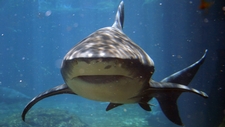Animal Characteristics are Related to Environments

TEKS Objective
The student is expected to investigate how the external characteristics of an animal are related to where it lives, how it moves, and what it eats.
Essential Understanding
The student knows that organisms resemble their parents and have structures and processes that help them survive within their environments.
Science Background
Arctic Adaptations: National Park Service (website) - Describes arctic animals and the characteristics that enable them to survive the harsh polar environment are described.
Arctic Adaptations
National Park Service, www.nps.gov
Animal Types and Characteristics: Colorado Sate University (website) - A collection of photographs and facts about animal characteristics.
Animal Types and Characteristics
Colorado State University, www.colostate.edu
Animals: National Geographic Kids (website) - Discover fascinating facts about the characteristics and behaviors of animals. Website includes pictures, videos, maps, and printable pictures with facts.
Animals
National Geographic Kids, kids.nationalgeographic.com
Signature Lesson
Animal Adaptations - Animal Disguises: SeaWorld/Busch Gardens (PDF) - Investigate how cryptic coloration helps ocean animals survive with their environments.
Animal Adaptations - Animal Disguises
Sea World/Busch Gardens, www.swbg-animals.org
- Supporting Lessons
- Extensions
- Assessment Ideas
- Literature Connections
- Related
TEKS - Additional Resources
Supporting Lessons
Who Am I? National Geographic (website) - Animals that live in the desert have many different external characteristics. Use this lesson to teach about those characteristics.
Who Am I?
National Geographic, www.nationalgeographic.com
Habitat: Sierra Club John Muir Study Guide (PDF) – Students learn about the naturalist, John Muir, and select a favorite animal and plant species to illustrate and describe.
Habitat
Sierra Club John Muir Study Guide, www.sierraclub.org
Elaboration Lessons and Extensions
Fishing Fun! Project Wild - Growing up Wild (PDF) - Children engage in a dramatic play fishing game and learn about fish.
Fishing Fun!
Project Wild - Growing up Wild, www.projectwild.org
Animal Diversity: Science NetLinks (website) - Observe how the environment may affect the physical characteristics of animals and plants.
Animal Diversity
Science NetLinks, www.sciencenetlinks.com
The Structure of Redworms - Animals Two by Two: FOSSWEB (PDF) - Observe the physical characteristics and behaviors of redworms. Use No. 14-17 reproducible sheets.
Assessment Ideas
Give students four pictures of different animals. Have each student identify and explain at least one external characteristic of each animal and discuss how that characteristic helps the animal to live and move.
Literature Connections
Skin, Scales and Shells. Miles, Elizabeth. (ISBN-13: 978-1403404305)
Why Mammals Have Fur. Hinshaw Patent, Dorothy. (ISBN-13: 978-0525651413)
Would You Survive? Townsend, John (ISBN-13: 978-1410919694)
Additional Resources
Animals on the Deadly 60: National Geographic (website) Discover the characteristics of 60 animals that make them the most dangerous animals in the world.
Animals on the Deadly 60
National Geographic, www.nationalgeographic.com
Science in the Schoolyard Video (Grade 2 Insects): FOSSWEB (website) - Observe as teachers and students take science outdoors to observe insects. Watch the video by selecting “Grade 2 (Insects).”
Science in the Schoolyard (Grade 2 Insects)
FOSSWEB, www.fossweb.com
Thermoregulation - Animal Sing Along: SeaWorld/Busch Gardens (PDF) - Through role play and song, students learn about warm and cold-blooded animals and demonstrate the behaviors used to dissipate excess body heat.
Thermoregulation - Animal Sing Along
Sea World/Busch Gardens, www.swbg-animals.org
TEKS Navigation
Grade 1
Need Assistance?
If you need help or have a question please use the links below to help resolve your problem.

Comments